Pana Atamans: freedom-loving insurgents of Ukraine or just bandits?
The “greens” are separate detachments to no one submitting to atamans and a “tatoo,” as they would say now, field commanders who have no coherent ideology and any real chance of asserting their authority within even a single territory. Many groups of "green" hunted outright criminality, actually connecting with the criminal world, others - where the leaders were more or less educated people with their own ideas about the political structure of society - still tried to follow a certain political course, albeit extremely blurry in ideological terms .
In this article we will talk about several such units operating in the territory of the Ukraine, which is modern Ukraine. Moreover, in the light of the events currently taking place in Donetsk and Lugansk, the topic of the Civil War, unfortunately, has again become topical.
First of all, it should be noted that, as in our days, there was no unity in the ranks of the Ukrainian nationalists of the early twentieth century. Getman Pavel Skoropadsky actually personified the interests of Germany and Austria-Hungary, Simon Petlyura sought a more independent policy, focusing on the creation of a "separatist" Ukrainian state and the inclusion of all lands in its structure, including even Don and Kuban.
In the struggle for "separatism", which had to be waged with both the whites - supporters of the preservation of the Russian Empire, and the red ones - supporters of the inclusion of Little Russian lands, only in the communist empire, Petliura relied not only on the units of the armed forces of the Ukrainian People's Republic, but also to the numerous detachments of the “battek” and the atamans, operating in fact throughout the territory of the then Little Russia. At the same time, they turned a blind eye to the overtly criminal tendencies of many “field commanders”, who preferred to rob and terrorize civilians rather than fight a serious organized opponent in the person of the regular army, be it the “white” Volunteer Army, or the “Red” Red Army.
"Green" - Terpilo
One of the largest detachments managed to form a man known by the romantic nickname "Ataman Zeleny". In fact, he wore a much more prosaic and even incongruous by the modern standards last name Terpilo. Daniel Ilyich Terpilo. At the time of the February revolution of 1917, followed by the collapse of the Russian Empire and the parade of sovereignties, including in Little Russia, Daniel Ilyich was thirty-one. But, despite his youth, there was a lot of life experience behind him - this was revolutionary activity in the ranks of the Socialist Revolutionary Party during the first Russian revolution of 1905-1907, with a five-year reference, and service in the imperial army during the First World War with titles ensign and production in the St. George Cavaliers.
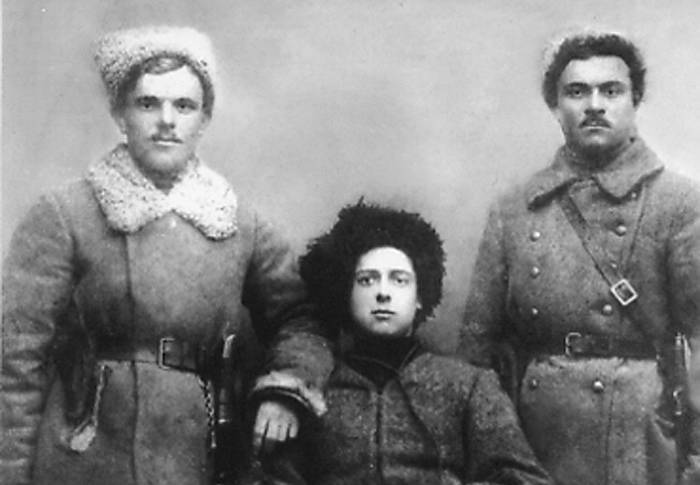
In the photo from left to right: centurion D. Lyubimenko, Ataman Zeleny, artilleryman V. Duzhanov (photo http://svpressa.ru)
Ataman Zeleny was from the Kiev Tripoli, returning to where after demobilization from the imperial army, he began to create there an organization of Ukrainian socialists of a nationalist kind. Despite the left phraseology, Green-Terpilo supported the independent Ukrainian authorities, including the Kiev Central Rada. Taking advantage of a certain prestige among the peasant population of the Kiev region, the Ataman Zeleny managed to form a rather impressive rebel detachment.
After the final transition to the side of the Directory of the Ukrainian People's Republic, the Green detachment received the name of the Dnieper Insurgent Division. The number of this unit reached three thousand fighters. Speaking on the side of the Petliurists, Green overthrew the power of Skoropadsky's supporters in Tripoli and disarmed the hetman Warta (guards). The Green Division was incorporated into the corps commanded by Eugene Konovalets. The future creator of the Organization of Ukrainian Nationalists, Konovalets - at that time a young twenty-seven-year-old lawyer from Lviv region - was one of the most visible military leaders of the Petliurism. It was the Siege Corps of Konovalets 14 of December that 1918 of the year took Kiev, overthrowing the hetman Skoropadsky and establishing the power of the UNR Directory.
However, Green’s view of Ukraine’s political future went against the Petliur doctrine of separatism. Green adhered to more leftist convictions and did not object to the participation of representatives of Bolsheviks and other leftist organizations in the Ukrainian government. On this Petliurists could not go and Green began to look for a union with the Bolsheviks proper. However, the Reds, represented by Vladimir Antonov-Ovseenko, who commanded the forces of the Red Army in Ukraine, did not agree with the proposed Green participation of his division as a fully autonomous unit in the Red Army.
However, since by that time two rebel divisions were already part of the First Insurgent of the Green, the ataman believed in his own potential and the ability to build a nationalist Ukrainian state without an alliance with any other external forces. The first rebel Kosh of the Green switched to active hostilities against the Red Army, acting together with another ataman, Grigoriev. "Green" even managed to free from the "red" Tripoli.
15 July 1919 of the year in a busy "green" Pereyaslav Ataman officially read the Manifesto on the denunciation of the Pereyaslav agreement 1654 of the year. Thus, the thirty-three-year-old field commander Terpilo canceled Hetman Bohdan Khmelnytsky’s decision to reunite with Russia. In September, 1919 rejected the previous left-wing views of the Green again recognizing the supremacy of Petliura and, by order of the Directory, abandoned his rebel detachments against Denikinites. However, for a long time Otaman Green failed to resist them. The fragment of the Denikin shell ended the stormy, but short life of the field commander.
The modern Ukrainian historian Kost Bondarenko, opposing Green to Nestor Makhno, emphasizes that if the latter was “the bearer of the steppe spirit,” Green was concentrating the central Ukrainian peasant worldview. However, it was in Makhno that, despite the lack of education, there was a worldview that allowed him to rise above the shtetl complexes, domestic nationalism and anti-Semitism, to express allegiance to some more global idea of the reorganization of society. Ataman Zeleny did not go beyond the framework of shtetl nationalism, which is why he could not create an army comparable to Makhnov, nor his own system of social organization. And if Makhno became a figure, if not of a world scale, then at least of an all-Russian scale, then Zeleny and other chieftains like him, which we will discuss below, still remain regional field commanders.
Strukovschina
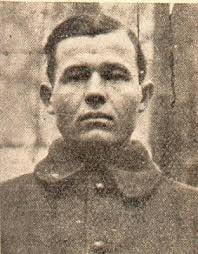 Another no less significant than Green, a figure of the Civil War in Little Russia on the part of the "rebels", was Ataman Ilya Struk. This figure is even more negative than Green, who had no political convictions. Ilya (Ilko) Struk was even younger than Zeleny for the period of the February Revolution - he was only 21 years old, behind him - service in the Baltic navy, the transition to the ground forces and the end of the school of ensigns, "Four George." Struk loved and knew how to fight, but, alas, he did not learn to think constructively. The three-thousandth detachment, formed by Struck from Little Russian peasants, was operating in the Northern Kiev region.
Another no less significant than Green, a figure of the Civil War in Little Russia on the part of the "rebels", was Ataman Ilya Struk. This figure is even more negative than Green, who had no political convictions. Ilya (Ilko) Struk was even younger than Zeleny for the period of the February Revolution - he was only 21 years old, behind him - service in the Baltic navy, the transition to the ground forces and the end of the school of ensigns, "Four George." Struk loved and knew how to fight, but, alas, he did not learn to think constructively. The three-thousandth detachment, formed by Struck from Little Russian peasants, was operating in the Northern Kiev region. Like Green, Struk tried to flirt with the Bolsheviks, seeing in them a serious force and hoping to make a military career in the event of the victory of the Red Army. However, the very absence of internal discipline and the ability to think constructively, two weeks after the Struck detachments joined the Red Army in February 1919, forced him to turn weapon against recent allies. In particular, Struk did not hide his anti-Semitism and organized bloody Jewish pogroms in the townships of the Northern Kiev region.
Ataman Struk was not deprived of a certain arrogance and called his unit no less than the first rebel army. Providing the detachment with food, money, clothing was carried out at the expense of the constant robberies of the civilian population and the banal racketeering of Jewish traders and tsehovikov of the Northern Kiev region. Struck's ambitions led him to storm Kiev 9 on April 1919. On this day, the current Ukrainian capital, defended by the Bolsheviks, withstood blows from three sides - Petliurists, the Green rebels and the Struk people attacked the city. However, the latter have manifested themselves in all their “glory” - like notorious rioters and marauders, but like worthless warriors. The Strukovtsy managed to plunder the Kiev suburbs, but the ataman’s attack on the city was repelled by small and weak in terms of preparation and arming of the Red Army detachments - a guard company and party activists.
However, in September, 1919, when Kiev was taken by Denikin, Struk’s detachments managed to break into the city, where they again marked pogroms and robberies, killing several dozen civilians. In the same period, the First Struck Rebel Army officially became part of the AI Volunteer Army. Denikin. Thus, Struk turned out to be a de facto traitor to his own idea of “separatism” - after all, Denikin did not want to hear about any Ukraine either. In October, 1919, when Denikinians and Red Army men mutually destroyed each other, Struk, without losing time, again broke into residential areas on the outskirts of the city and repeated the pogroms and looting of the previous month. Nevertheless, the Denikin Command, which appreciated the very fact that one of the Ukrainian field commanders was passing to its side, did not object strongly to the pogrom activity of the Strukhovites. The ataman was promoted to colonel, which naturally flattered the vanity of the 23-year-old “warlord”, and in fact, the ataman of the gangster gang.
After Kiev was finally liberated by the Red Army in December 1919, the Struck detachments, together with Denikin, retreated to Odessa. However, Struck could not show his heroism in the defense of Odessa and after the onslaught of the “Reds” retreated, through the territory of Romania to Ternopil and then to his native Kyiv region. At the beginning of 1920, we see Struck already in the ranks of the allies of the Polish army, advancing on Kiev, occupied by the Bolsheviks.
From 1920 to 1922 detachments of the Strukhovtsy, significantly reduced in number after the defeat by the Bolsheviks, still continued to operate in Polesie, terrorizing the local population and being engaged mainly in the murder and robbery of Jews. By the fall of 1922, the Struck squad did not exceed the number of people in 30-50, that is, it turned into an ordinary gang. It ceased to exist after Ilya Struck himself miraculously moved to Poland. By the way, the fate of the chieftain was quite happy. Unlike other leading figures of the Civil War in Ukraine, Struk safely lived to old age and died in 1969 in Czechoslovakia, half a century after the Civil War.
Even against the background of other rebel chieftains of the Civil War in Ukraine, Ilya Struck looks ominous. In fact, he was not so much a military leader as a pogromist and bandit, although he could not be deprived of his well-known personal courage and adventurism. It is also of great interest that Struk left behind his memories of his role in the Ukrainian confrontation, which, despite all the exaggerations and the desire for self-justification, are historical interest, if only because other atamans at the Struk level did not leave such memories (unless, of course, “lower” Nestor Ivanovich Makhno, a completely different order, to Struk or Zeleniy).
Pogromschik Grigoriev
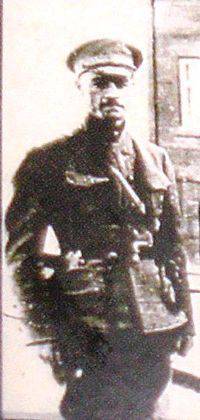 Matvey Grigoriev, like Struk, was neither distinguished by political scruples, nor by excessive morality. Famed for his incredible cruelty during the pogroms and robberies he carried out, Grigoriev was personally shot dead by Nestor Makhno, probably the only ataman who could not tolerate violence against civilians and manifestations of nationalism. Initially, Grigoriev was called Nikifor Aleksandrovich, but in Ukrainian historical literature he also gained fame by his second name — his nickname — Matvey.
Matvey Grigoriev, like Struk, was neither distinguished by political scruples, nor by excessive morality. Famed for his incredible cruelty during the pogroms and robberies he carried out, Grigoriev was personally shot dead by Nestor Makhno, probably the only ataman who could not tolerate violence against civilians and manifestations of nationalism. Initially, Grigoriev was called Nikifor Aleksandrovich, but in Ukrainian historical literature he also gained fame by his second name — his nickname — Matvey. A native of Kherson region, Grigoriev was born in 1885 year (according to other data - in 1878) and received a secondary medical education in medical assistant school. Unlike other atamans, Grigoriev visited two wars at once - the Russian-Japanese war, which reached the rank of ensign, and the First World War. After the Russo-Japanese War, Grigoriev graduated from an infantry school in Chuguev, received the rank of ensign and served for some time in an infantry regiment stationed in Odessa. Grigoriev met the First World War with an mobilized officer of the 58 Infantry Regiment, reached the Captain and at the time of the February 1917 Revolution, he was appointed head of the training team of the 35 reserve regiment stationed in Feodosia.
Grigoriev managed to go on the side of Hetman Skoropadsky, and in the ranks of Petliurists, and in the Red Army. The first time after the proclamation of the power of Hetman Skoropadsky, Grigoriev retained the loyalty of the Ukrainian Stainless and served as commander of an infantry regiment company, but then moved to the area of Elisavetgrad, where he began a partisan war against the hetman's power. By the end of 1918, under the command of Grigoriev, there were about six thousand people united in the Kherson Division of the Ukrainian People’s Republic. “The megalomania” of Grigoriev was manifested in the demand for the post of minister of war from the leadership of the Directorate of the UNR, however, Petliura did what he did the most — conferred the rank of colonel on Grigoriev. Insulted chieftain did not fail to go over to the side of the advancing Red Army.
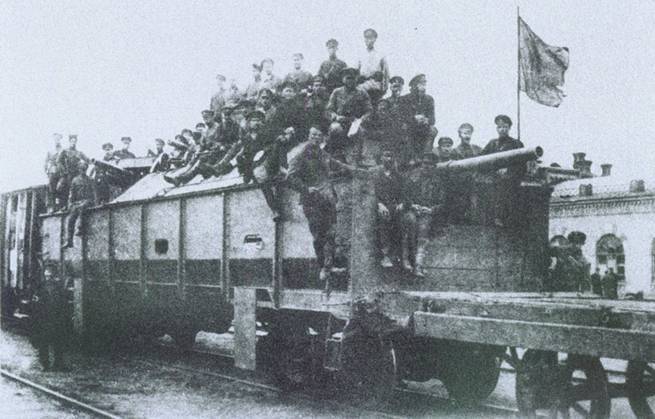
Armored train Ataman Grigoriev. Xnumx
As part of the Red Army, Grigoriev’s division, called the 1 of the Zadneprovsky Brigade, was part of the 1 of the same name of the Zadneprovskaya division, commanded by legendary sailor Pavel Dybenko, who was ideologically floating between left-wing Bolshevism and anarchism. After the capture of Odessa, it was Grigoriev who was appointed its military commander, and this, in many respects, led to numerous arbitrary expropriations and banal robberies committed by his subordinates not only in relation to the food and other stocks of the city, but also in respect of ordinary citizens. The Grigoriev Brigade was renamed the 6-th Ukrainian Rifle Division and was preparing to be sent to the Romanian front, but the ataman-division commander refused to follow the orders of the Bolshevik leadership and took his units to rest under Elisavetgrad.
Dissatisfaction with the Bolsheviks Grigoriev and Grigoriev with the Bolsheviks grew in parallel and resulted in an anti-Bolshevik uprising, which began on May 8 and 1919 of the year, which was called the Grigorievsky insurrection. Returning to nationalist positions, Grigoriev called on the Little Russian population to form the “Soviets without Communists.” The Chekists sent by the command of the Red Army were destroyed by the Grigorievka. Ataman ceased to hide his pogrom mood. It is known that Grigoriev was not only an anti-Semite, because of his hatred of the Jews, giving a head start to almost all other “batka-atamans”, but also a notorious Russophobe, who hated the Russians, who lived in the cities of Little Russia and adhered to the conviction of the physical destruction of Russians on Little Russia. .
Alexandria, Elisavetgrad, Kremenchug, Uman, Cherkasy — a wave of bloody pogroms swept through all these cities and smaller towns and suburbs, not only Jews, but also Russians. The number of civilians killed as a result of the Grigoriev riots reaches several thousand people. In Cherkassy alone, three thousand Jews and several hundred Russians were killed. The Russians, called the “Muscovites” by the Gregorians, were also considered as the most important targets of pogroms and massacres.
However, during the second half of May 1919, the Bolsheviks were able to defeat the Grigorievsk and significantly reduce the number of formations under his control. Ataman went to the union with the anarchist "father" Nestor Makhno, which ultimately cost him his life. For the anarchist and internationalist Makhno, any manifestations of Grigoriev’s pogromic nationalism were unacceptable. In the end, Makhno, dissatisfied with the Ukrainian nationalism propagated by Grigoriev, established observation of the ataman and revealed that the latter was conducting secret negotiations with Denikinians. This was the last straw. 27 July 1919 of the year in the village council in the village of Sentovo Makhno and his assistants attacked Grigoriev. Adjutant Makhno Chubenko personally shot Grigoriev, and Makhno shot his bodyguard. Thus, another Ukrainian ataman, who brought much sorrow and suffering to peaceful people, ended his life.
"Ataman" as destrukt
Of course, the “Batkivschyna” on the Little Russian and Novorossiysk lands during the Civil War was not limited to the Green, Struck and Grigoriev. The territory of modern Ukraine was being torn apart by rebel armies, divisions, detachments, and simply gangs of dozens or even hundreds of large and small field commanders. Examples of the life course of the three atamans examined allow us to reveal a number of common features in their behavior. First, it is political unscrupulousness, which allowed them to block with anyone against anyone, guided by short-term gain or simply self-interest. Secondly, it is the absence of a coherent ideology, populism, based on the exploitation of the nationalist prejudices of the "gray mass". Thirdly, it is the propensity to violence and cruelty, which makes it easy to cross the line that separates insurgents and simply thugs.
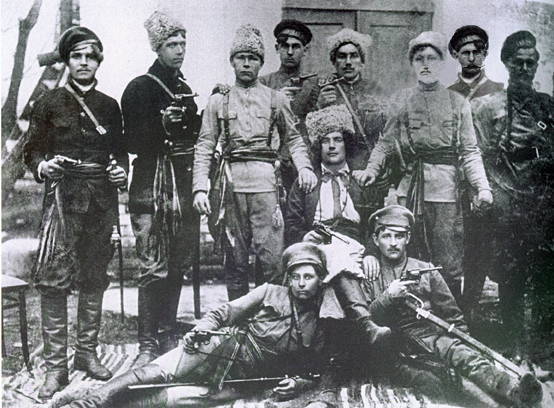
Anarchist Rebels
At the same time, it is impossible not to recognize such features of the "atamanism" as the personal courage of its leaders, without which they probably could not have led their own troops; some support from the peasantry, whose interests really expressed the slogans of land distribution without buying out or canceling surplus; the effectiveness of the organization of partisan detachments, many of which operated for three to five years, while maintaining mobility and escaping from the blows of superior strength and organization of the enemy.
Studying the history of the Civil War in Ukraine helps to realize how deconstructive in nature the small-town nationalism of the "Pan-Atamans". Formed, first of all, as an opposition to everything Russian, that is, on the basis of “negative identity”, the artificial construct of Ukrainian nationalism in a critical situation inevitably transforms into “Fatherland”, into feuds between “Pan-Atamans”, political adventurism and, ultimately, criminal banditry. Thus began and ended the detachments of “Pan-Atamans” both during the Civil War and during the Great Patriotic War after the defeat of Nazi Germany. Nationalist leaders could not even agree among themselves, not to mention building an effectively functioning sovereign state. So Petliura and Grigoriev, Zeleny and Struk cut each other, eventually giving way to political space for those forces that were more constructive.
Information